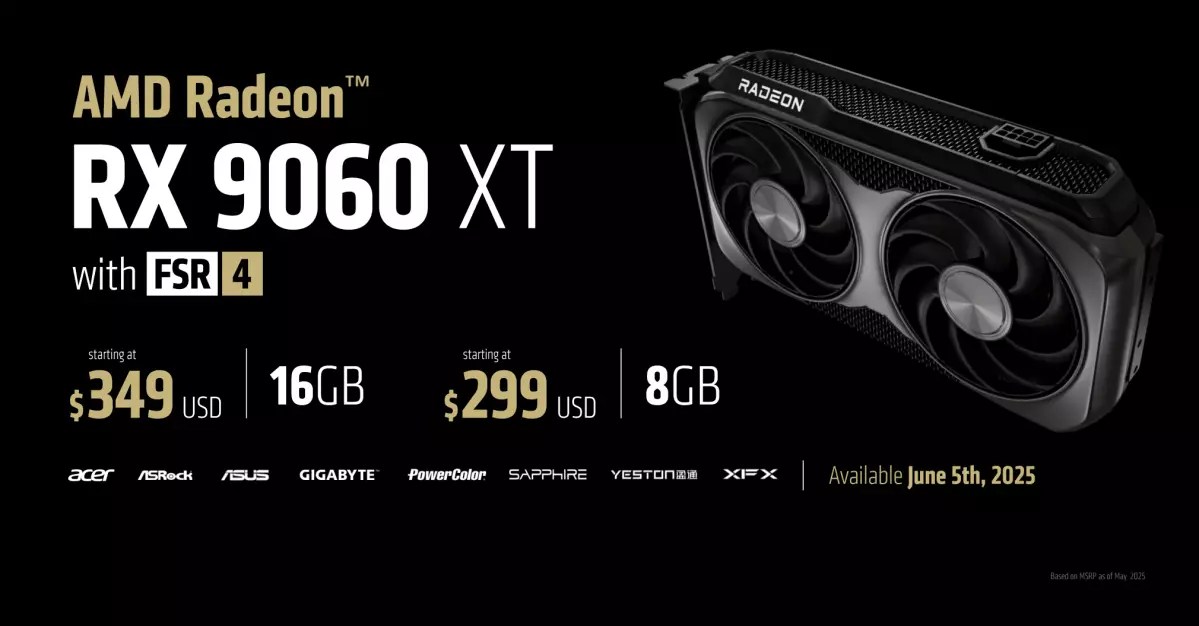AMD has taken a significant step towards reclaiming its position in the competitive graphics processing unit (GPU) market with the announcement of the Radeon RX 9060 XT at Computex. While detailed specifications and features have been laid out, one glaring omission remains: the price and release date. This decision is puzzling at best, especially as the market is rife with anticipation over the performance capabilities of both AMD’s latest offering and its rival Nvidia’s new RTX 5060 lineup.
The RX 9060 XT aims to take on the recently launched RTX 5060 and RTX 5060 Ti—both of which sparked heated discussions among enthusiasts regarding their memory capacities. As GPUs evolve and games become more resource-intensive, the 8GB of VRAM offered by these models raises eyebrows among gamers. AMD’s dual offering of 8GB and 16GB variants begs the question: Did they merely follow Nvidia’s lead, or do they have a plan to justify the higher memory allocation?
Specifications That Impress
The technical specifications of the RX 9060 XT paint a compelling picture for prospective users. Equipped with 32 RDNA 4 compute units and capable of boosting clock speeds up to 3.13GHz, AMD appears committed to delivering solid performance, particularly at 1440p resolution. The support for cutting-edge technologies like DisplayPort 2.1a and HDMI 2.1b illustrates AMD’s intention to cater to a market that prioritizes future-proofing through enhanced connectivity.
Furthermore, AMD claims the 16GB version will outpace Nvidia’s RTX 5060 Ti by about 6% in performance across various titles, a bold assertion that is likely to draw attention from gamers and reviewers alike. This competitive edge could signal a much-needed shift in user perception regarding AMD’s capabilities, primarily if their claims hold up under scrutinized testing conditions.
The Memory Dilemma
The ongoing debate surrounding the use of 8GB versus 16GB of VRAM is one that cannot be ignored. As gaming technology continues to advance, the requirement for higher memory to cater to rich visual experiences and expansive game worlds is becoming increasingly pressing. By releasing a mid-range GPU that offers both memory options, AMD has strategically positioned itself in a market that is unsure how to tackle the VRAM issue.
Nvidia’s recent controversies surrounding their decision to market the RTX 5060 with only 8GB of memory have undoubtedly created a ripple effect, pushing AMD to respond in a manner that could help sway gamer sentiment. However, the questionable timing of Nvidia’s launch, accompanied by their attempts to limit the flow of information to reviewers, suggests that they are acutely aware of potential vulnerabilities in their product lineup. This atmosphere of tension raises the stakes for both companies as they navigate these competing narratives.
The Reviewer’s Perspective
The role of technology reviewers and influencers has never been more critical in driving consumer choices in such a competitive landscape. Gamers Nexus’ expose on Nvidia’s alleged pressuring of reviewers to conform to specific narratives surrounding Multi Frame Generation (MFG) has powerful implications for the perception of both Nvidia and AMD. The stakes in this rivalry are about more than just hardware; they delve into ethics, transparency, and the trust that consumers place in tech giants.
As AMD gears up for its expected release in June, the anticipation surrounding the RX 9060 XT will culminate in scrutinized benchmarks and user feedback. This might very well determine the longevity of AMD’s gains in a market predominated by Nvidia’s offerings. The AMD team will need to ensure that their marketing strategies do not fall prey to the pitfalls that Nvidia has recently found itself embroiled in, especially with community scrutiny more pronounced than ever.
The Future of Graphics Technology
The RX 9060 XT represents more than just a direct challenge to Nvidia; it embodies a pivotal moment for AMD. By actively engaging in the performance vs. memory capacity debate, AMD can create a narrative that not only emphasizes their new technology but also educates consumers about the ever-increasing demands of modern gaming.
In a landscape where innovation is fast-paced and constant, AMD must leverage its competitive advantages effectively while managing the expectations and criticisms from the community. The road ahead will be defined not just by technical specifications but also by AMD’s ability to communicate transparently and authentically with their consumer base, as they strive to establish themselves as a powerhouse in the GPU market once more.


Leave a Reply